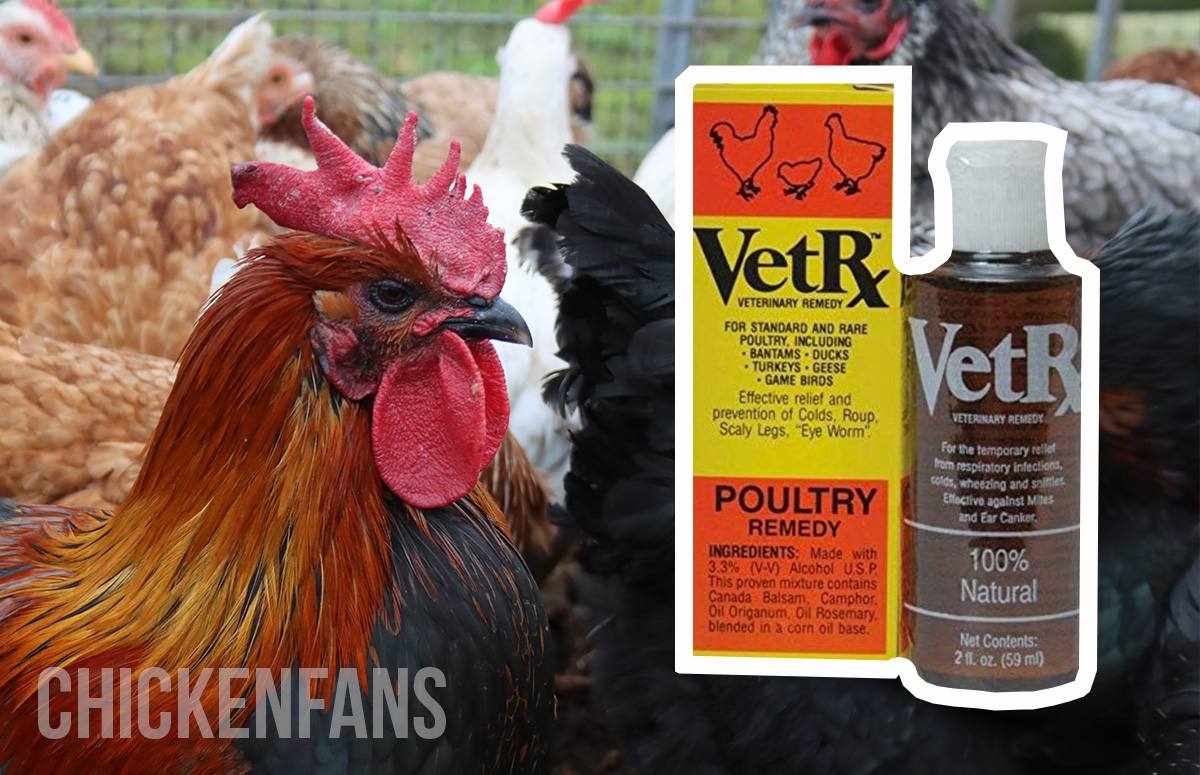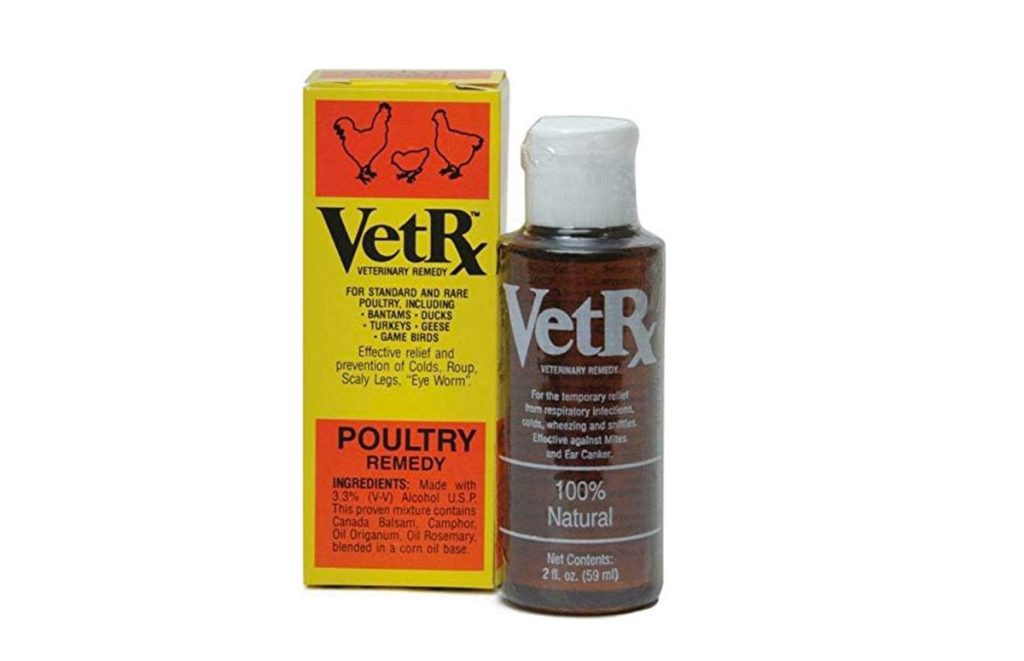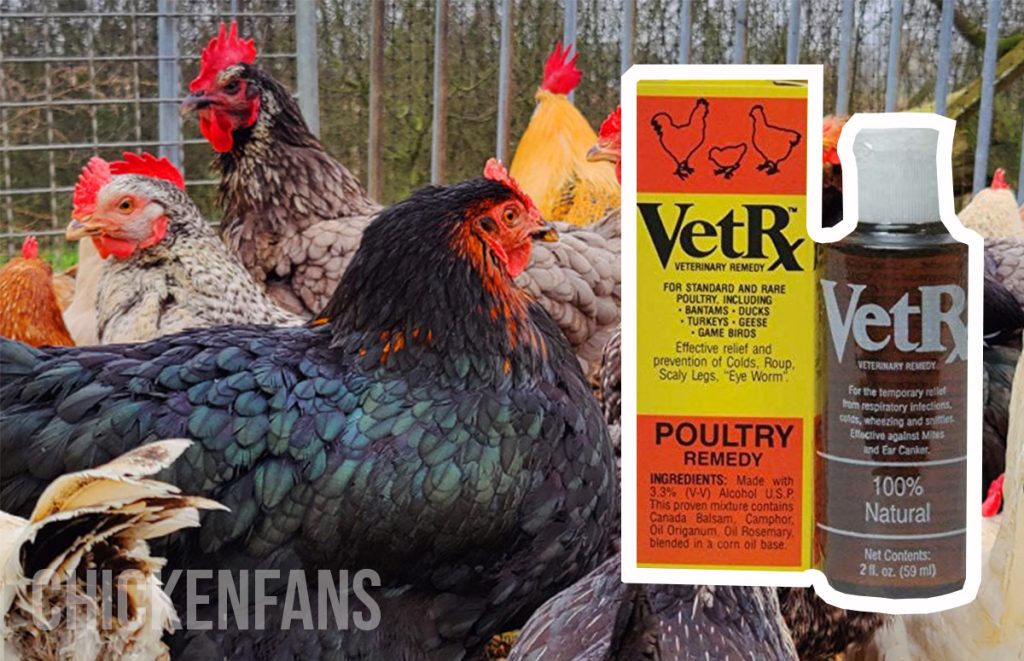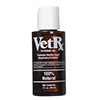VetRX Poultry Aid for Chickens

Chicken Fans is reader-supported. When you buy through our links, we may earn a commission. Learn more about our privacy policy and disclaimer.

VetRX is one of the most popular all-natural remedies for common colds in chickens. Many experienced chicken fans have a VetRX Poultry bottle in their first aid kit. It’s considered the Vicks VapoRub of the poultry world.
| Effective against | Respiratory issues, Sneezing, Coughing, Dry Legs |
| Not effective against | Injuries, Parasites, Fungi |
| Type of medicine | Natural Remedy |
| Manufacturer | Goodwinol Products Corporation |
| Active Ingredient | Oil blend: Camphor, Origanum, Rosemary + Alcohol |
| Egg withdrawal period | No withdrawal period |
| Meat withdrawal period | No withdrawal period |
| Effective within | Up to 24 hours |
| Dosage Treatment | Solution: 1 tsp / 1 cup warm water Direct: a few drops down the throat at night Topical: a few drops on the eyes and under the wings Vaporizer: 1 tsp. 1/2 cup warm water 1hr at night |
| Extra Instructions | Use VetRx warm; heat at medium temperature |
| Side Effects | No known side effects |
| Alternatives | Essential oils, Herbal solutions |
This article will explain everything you need to know about VetRX Poultry Aid for Chickens – from ingredients and working mechanisms to main uses and dosage directions. Let’s dive in.
- Place a few drops of warm VetRx down the throat of the bird at night. Or dissolve VetRx in the drinking water (one drop for one cup).
What is VetRX Poultry Aid?
VetRx Poultry Aid is the most popular natural remedy to treat upper-respiratory issues in poultry. It relieves sneezing, coughing, and nasal discharge in chickens, ducks, and turkeys. VetRx is an oil blend of camphor, origanum, and rosemary applied topically or via drinking water.
VetRx Poultry Aid is like the bird’s equivalent to the popular Vicks Vaporub but with a broader specter of use. VetRX is natural and, therefore, safe for all standard and rare poultry, such as chickens, ducks, turkeys, geese, and game birds.

VetRx Poultry Aid Uses
VetRx aids in treating various conditions, such as:
- Respiratory Issues: VetRx can help alleviate symptoms related to upper respiratory conditions in chickens, like coughing, sneezing, facial swelling, and difficulty breathing. Chicken respiratory diseases include Chronic Respiratory Disease, Coryza, Infectious Bronchitis, and Fowl Pox.
- Scaly Legs: scaly leg mites can cause severe irritation, itching, and eventually inflammation of the chicken’s legs and feet. VetRx has antiseptic properties and a soothing effect that can help reduce mites and offer relief from itching.
- Eye Worms: a parasitic eye condition caused by a roundworm that lives under the third eyelids and irritates the eyes, causing discomfort. VetRx can temporarily alleviate eye irritation or discomfort.
- Conditioner for Show Chickens: VetRX is used to reduce the risk of issues associated with transportation. Additionally, when applied on the wattles, comb, and legs, VetRX helps bring out their natural color and luster.
- Breeding Tonic: breeders use VetRx as general flock care to ensure the optimal health of their hens and to support maximum egg production.
VetRX Poultry Aid Dosage & Usage Instructions
VetRX can be used externally or internally, and it can be sprayed, rubbed, mixed with water, or given directly into the mouth. Always use VetRx warm unless otherwise specified.
| Application | Dosage | How to apply |
|---|---|---|
| Topical | 2 fingertips | Rub the solution on their heads, wattles, comb, and under the wings. Chickens inhale the VetRx vapors when they sleep with their head under their wings |
| Direct Mouth | 3 drops undiluted | Place three drops of warm VetRx, straight from the bottle, down the throat of the bird at night |
| Vaporizer | 1 cup > 1hr, full strength | Use a hot water model vaporizer for at least one hour while the birds roost, filled with VetRx at full strength |
| Sprayer | 1 tsp. / 1 cup warm water | Spray warm VetRx over the chickens |
| Diffuser | 1-1.5 tsp. / 1 cup warm water, > 1hr | Use a hot water diffuser model and operate for at least one hour while birds are roosting |
| Coop Litter | 2-5 drops / 10 sq. ft. | Sprinkle into the coop litter |
| Feed | 1 bottle + 3 quarts lay mash (~3l) | Combine three quarts of lay mash warmed at room temperature with an entire bottle of VetRX and let the mixture in a warm room overnight. Then put it in a sealed container for two weeks. Add one tablespoon to regular feed daily for up to 20 chickens. |
| Drinking Water | 2-5 drops in cold water | It will float on the water and get on the beaks and nostrils each time the chickens drink |
| Dressing | 2-5 drops or 1 tsp/cup diluted | Rub thoroughly on beaks, combs, wattles, shanks, and toes. Apply once a day for three days |
| Dry shanks | A small amount of cold VetRx | Rub thoroughly all over the shanks and toes. Repeat every three days until the legs are no longer dry |
| Direct on Cleft Palate | Dips of warm VetRx | Turn the chicken’s head to the side and tilt it downward while opening its beak to get a clear view of the cleft on the mouth’s roof. Press a cotton swab dipped in warm VetRx directly into the cleft. Wait for the solution to come from each eye corner and each side of the beak. |
Most people directly apply the VetRx on the chicken’s head, wattles, comb, and under the wings. Here is how you apply VetRx topically:
- Hold the chicken under your arm to free both hands
- Put some VetRx on your fingertips and apply it to the comb
- Do the same for the beak and wattles
- Lift one wing and apply VetRx at the base of the wing
- Do the same for the other wing
VetRX Poultry Aid Ingredients
VetRX is made with natural ingredients such as camphor (2%), Canada balsam, oil origanum, and oil rosemary blended in a corn oil base and 3.3% (v-v) alcohol.
Here are the active ingredients:
- Canada Balsam: Known as fir balsam oil, it is used to treat burns and wounds, while the essential oil of Canada balsam is used against coughs and colds
- Camphor: White camphor oil provides respiratory relief and is a common ingredient in cold rubs and decongestant balms
- Oil Origanum: Extracted from oregano leaves and flowers, oregano oil is a very potent antimicrobial
- Oil Rosemary: Rosemary oil has potent anti-inflammatory, antimicrobial, anticancer, antioxidant, and expectorant (helps with coughing) properties

Camphor
The first ingredient of VetRx is Camphor. It is commonly used in over-the-counter products like vapor rubs, inhalers, and balms to relieve respiratory issues. Here is why:
- Vasodilation: camphor acts as a mild vasodilator, increasing blood flow to the area where it’s applied; this helps reduce congestion
- Cooling effect: it produces a cooling sensation when it comes in contact with the skin or when it’s inhaled so that the chicken can breathe more comfortable
- Nerve stimulation: camphor stimulates the nerve endings that register heat and cold; this can distract the chicken from other discomforts, like a sore throat.
- Expectorant: the vapors from camphor can help loosen mucus and phlegm, making it easier to cough up
Origanum (Oregano Oil) & Rosemary Oil
The origanum and rosemary oil in VetRx have antimicrobial and anti-inflammatory properties, which help chickens fight respiratory issues.
Oregano oil is mainly known for its potent antimicrobial effects and potential to boost the immune system. Rosemary oil is valued for its antioxidant and expectorant properties. It helps to clear mucus from the respiratory tract of chickens.
SD-Alcohol 40B (3.3%)
SD-Alcohol 40B (3.3%) refers to specially denatured alcohol. It is basically ethanol treated with denaturants to make it undrinkable. This is commonly done for alcohols used in cosmetics, personal care products, and some over-the-counter medicines to avoid beverage taxes and to deter consumption.
The “40B” specifies the particular formulation of denaturants used, and “3.3%” indicates the concentration of this alcohol in the VetRx product.
The alcohol in VetRx serves various purposes:
- Solvent: it helps dissolve or disperse all the oils in the mix
- Antiseptic: alcohol has antiseptic properties, which help to kill or inhibit bacteria when applied topically on the chicken’s head or wings
- Preservative: the alcohol extends the shelf life by preventing the growth of microbes in the bottle
The concentration of 3.3% alcohol in VetRx is so low that it’s no problem for your chickens when applied topically or by using only a few drops as directed.
What Causes the Strong Smell of VetRx?
The sharp scent of VetRx – similar to Vicks VapoRub – is due to the Camphor and Oil Origanum (oregano oil).
Camphor has a strong, penetrating, and somewhat medicinal odor. It is commonly used in cold rubs and decongestant balms for its respiratory relief properties. Oregano oil also has a strong, herbaceous, and somewhat medicinal scent.
What’s the Origin of VetRx Poultry Aid?
VetRx Poultry is produced by Goodwinol and is based on a formula that didn’t change in 100 years. The formula was first invented in 1874 and was used to treat croup in children.
Goodwinol also has other VetRx products for other animals and is known for producing veterinary products, including animal ointments and shampoos. One of their other well-known products is Goodwinol ointment, often used for treating skin conditions like mange in dogs.
- Place a few drops of warm VetRx down the throat of the bird at night. Or dissolve VetRx in the drinking water (one drop for one cup).
VetRx Poultry Aid Alternatives
In theory, all active ingredients in VetRX, including Canada balsam, camphor, oil origanum, and oil rosemary, can be found separately and used as an alternative.
However, in practice, it is best to find and use the original product. Each component is included in a specific amount and boosts the effects of the rest of the ingredients.
Conclusion: VetRx Poultry Aid for Chickens
VetRx is essential to every backyard chicken keeper’s first aid kit. The formula is one of the most popular natural remedies for poultry and is used in treating respiratory issues, scaly legs, and eye worms.
VetRx is readily available and can be found online and in pet stores. The remedy is sold over the counter and is relatively affordable, considering its effectiveness.
Consult a licensed vet when needed or when you do not have previous experience with the product.
Yes, you can eat eggs or meat from chickens that are taking VetRX Poultry Aid. VetRX is an all-natural remedy that does not affect the safety of eggs and meat. Therefore, there is no egg or meat withdrawal period when it comes to VetRX.
VetRX starts working as soon as it is absorbed through the skin (with external use) or intestines (with internal use). However, depending on the chicken’s health and underlying issues, it may take a few hours to a few days to notice a visible improvement.
No, VetRx is only for use in animals, not for human ingestion. Follow the instructions and keep VetRx out of reach for children.

Dr. I. Crnec is a licensed veterinarian with several years of experience. She has published work on the effect of vitamin supplementation, egg-laying performances of chickens under heat-stress conditions and the effects of calcium supplementation on eggshell strength.
























